Alpine CDE-173BT, CDE-174BT, UTE-72BT Owner Manual
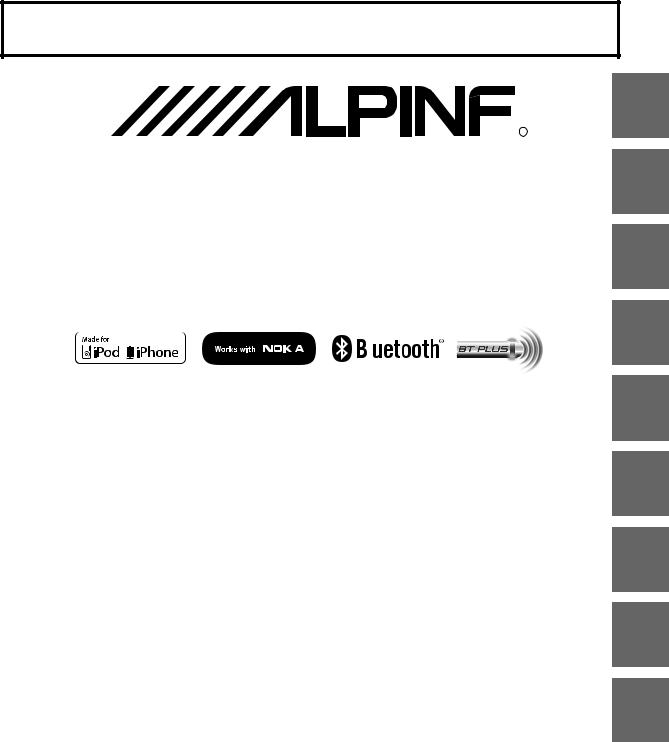
FOR CAR USE ONLY/NUR FÜR AUTOMOBIL GEBRAUCH/POUR APPLICATION AUTOMOBILE UNIQUEMENT/PARA USO EN AUTOMÓVILES/SOLO PER L’UTILIZZO IN AUTOMOBILE/ENDAST FÖR BILBRUK/ALLEEN VOOR GEBRUIK IN DE AUTO/ ТОЛЬКО ДЛЯ ИСПОЛЬЗОВАНИЯ В АВТОМОБИЛЯХ/DO UŻYCIA TYLKO W SAMOCHODZIE
EN
 R
R
CD/USB RECEIVER WITH ADVANCED BLUETOOTH
CDE-174BT/CDE-173BT
DIGITAL MEDIA RECEIVER WITH ADVANCED BLUETOOTH
UTE-72BT
|
|
|
|
|
|
|
|
|
|
|
|
|
|
|
|
|
|
|
|
|
|
|
|
|
|
|
• |
OWNER’S MANUAL |
|
|
|
• |
ANVÄNDARHANDLEDNING |
||
|
Please read before using this equipment. |
|
|
|
Innan du använder utrustningen bör du läsa |
|||
|
|
|
|
|
|
igenom denna användarhandledning. |
||
• |
BEDIENUNGSANLEITUNG |
|
|
|
• |
GEBRUIKERSHANDLEIDING |
||
|
Lesen Sie diese Bedienungsanleitung bitte vor |
Lees deze aanwijzingen aandachtig alvorens dit |
||||||
|
Gebrauch des Gerätes. |
|
|
|
|
toestel te gebruiken. |
||
• |
MODE D’EMPLOI |
|
|
|
• |
РУКОВОДСТВО ПО ЭКСПЛУАТАЦИИ |
||
|
Veuillez lire avant d’utiliser cet appareil. |
|
|
|
Прочтите настоящее руководство перед |
|||
|
|
|
|
|
|
началом использования оборудования. |
||
• |
MANUAL DE OPERACIÓN |
|
|
|
• |
INSTRUKCJA OBSŁUGI |
||
|
Léalo antes de utilizar este equipo. |
|
|
|
Prosimy zapoznać siç z tą instrukcją przed |
|||
|
|
|
|
|
|
przystąpieniem do użytkowania urządzenia. |
||
• |
ISTRUZIONI PER L’USO |
|
|
|
|
|
|
|
|
Si prega di leggere prima di utilizzare il |
|
|
|
|
|
|
|
|
attrezzatura. |
|
|
|
|
|
|
|
|
|
|
|
|
|
|
||
|
ALPINE ELECTRONICS MARKETING, INC. |
ALPINE ELECTRONICS OF AUSTRALIA PTY. LTD. |
ALPINE ELECTRONICS FRANCE S.A.R.L. |
|||||
|
1-7, Yukigaya-Otsukamachi, Ota-ku, |
|
161-165 Princes Highway, Hallam |
(RCS PONTOISE B 338 101 280) |
||||
|
Tokyo 145-0067, JAPAN |
|
Victoria 3803, Australia |
98, Rue de la Belle Etoile, Z.I. Paris Nord Il, |
||||
|
Phone: 03-5499-4531 |
|
Phone 03-8787-1200 |
B.P. 50016, 95945 Roissy Charles de Gaulle |
||||
|
ALPINE ELECTRONICS OF AMERICA, INC. |
|
ALPINE ELECTRONICS GmbH |
Cedex, France |
||||
|
|
Phone 01-48638989 |
||||||
|
19145 Gramercy Place, Torrance, |
Wilhelm-Wagenfeld-Str. 1-3, 80807 München, Germany |
|
|||||
|
California 90501, U.S.A. |
|
Phone 089-32 42 640 |
ALPINE ITALIA S.p.A. |
||||
|
Phone 1-800-ALPINE-1 (1-800-257-4631) |
|
ALPINE ELECTRONICS OF U.K. LTD. |
Viale C. Colombo 8, 20090 Trezzano |
||||
|
ALPINE ELECTRONICS OF CANADA, INC. |
|
Sul Naviglio (MI), Italy |
|||||
|
|
Alpine House |
|
|
Phone 02-484781 |
|||
|
777 Supertest Road, Toronto, |
Fletchamstead Highway, Coventry CV4 9TW, U.K. |
|
|||||
|
Ontario M3J 2M9, Canada |
|
Phone 0870-33 33 763 |
ALPINE ELECTRONICS DE ESPAÑA, S.A. |
||||
|
Phone 1-800-ALPINE-1 (1-800-257-4631) |
|
|
|
|
|
|
Portal de Gamarra 36, Pabellón, 32 |
|
|
|
|
|
|
|
|
01013 Vitoria (Alava)-APDO 133, Spain |
|
|
|
|
|
|
|
|
Phone 945-283588 |
DE
FR
ES
IT
SE
NL
RU
PL
Designed by ALPINE Japan 68-21627Z78-A

Contents |
ENGLISH |
|
|
Operating Instructions |
|
WARNING |
|
WARNING....................................................... |
6 |
CAUTION ........................................................ |
6 |
PRECAUTIONS ............................................... |
6 |
Getting Started |
|
Accessory List ............................................................... |
9 |
Turning Power On and Off....................................... |
9 |
Source Selection.......................................................... |
9 |
Detaching and Attaching the Front Panel ......... |
9 |
Detaching .................................................................. |
9 |
Attaching ................................................................... |
9 |
Initial System Start-Up............................................ |
10 |
Adjusting Volume .................................................... |
10 |
Radio |
|
Listening to Radio.................................................... |
10 |
Presetting Stations Manually............................... |
10 |
Presetting Stations Automatically...................... |
11 |
Tuning to Preset Stations ...................................... |
11 |
Frequency Search Function.................................. |
11 |
RDS |
|
Turning AF (Alternative Frequencies) |
|
ON/OFF........................................................................ |
11 |
Receiving RDS Regional (Local) Stations ......... |
12 |
PI SEEK Setting .......................................................... |
12 |
Receiving Traffic Information............................... |
12 |
Receiving Traffic Information While Playing |
|
USB Audio or Radio ................................................. |
12 |
Displaying Radio Text ............................................. |
12 |
CD/MP3/WMA/AAC |
|
(CDE-174BT/CDE-173BT only) |
|
Playback ....................................................................... |
13 |
Repeat Play ................................................................. |
13 |
M.I.X. (Random Play)................................................ |
13 |
Searching for CD Text.............................................. |
13 |
Folder/File Name Search |
|
(concerning MP3/WMA/AAC) .............................. |
14 |
Folder Name Search mode................................ |
14 |
File Name Search mode ..................................... |
14 |
Search Position Memory ........................................ |
14 |
About MP3/WMA/AAC ........................................... |
14 |
Terminology ........................................................... |
15 |
Sound Setting |
|
Adjusting Subwoofer Level/Bass Level/Mid |
|
Level/Treble Level/Balance (Between Left and |
|
Right)/Fader (Between Front and Rear)/ |
|
Defeat............................................................................ |
16 |
Audio Setup................................................................ |
16 |
Equalizer Presets (F-EQ)...................................... |
16 |
Adjusting the Parametric Equalizer Curve |
|
(3BAND EQ)............................................................. |
17 |
Setting the Bass Control .......................................... |
17 |
Setting the Mid Control ........................................... |
17 |
Setting the Treble Control....................................... |
17 |
Setting the Source Volume Level.................... |
18 |
Adjusting the High Pass Filter .......................... |
18 |
Turning Subwoofer ON/OFF............................. |
18 |
Adjusting the Low Pass Filter ........................... |
18 |
Setting the Subwoofer Phase........................... |
18 |
Setting the Subwoofer System........................ |
18 |
External Device...................................................... |
18 |
Connecting to an External Amplifier |
|
(POWER IC).................................................................... |
18 |
Setting the MX Level ........................................... |
19 |
Other Functions |
|
Displaying the Text................................................... |
19 |
About “Text” ........................................................... |
20 |
Using the Front AUX Input Terminal.................. |
20 |
Option Menu Setting .............................................. |
20 |
3-EN
Contents |
ENGLISH |
|
|
SETUP |
|
Setting.......................................................................... |
21 |
General Setting..................................................... |
22 |
Setting the Menu Language .................................. |
22 |
Setting the AUX SETUP mode................................ |
22 |
Setting the AUX NAME mode ................................ |
22 |
Playing MP3/WMA/AAC Data (PLAY MODE) |
|
(CDE-174BT/CDE-173BT only)................................ |
22 |
Demonstration............................................................ |
22 |
Display Setting...................................................... |
22 |
Changing Lighting Colour |
|
(CDE-174BT/CDE-173BT only)................................ |
22 |
Dimmer Control .......................................................... |
22 |
Scroll Setting (TEXTSCROLL) .................................. |
22 |
Scroll Type Setting ..................................................... |
23 |
Tuner Setting......................................................... |
23 |
Setting the TUNER (FM) tone quality .................. |
23 |
iPod/iPhone Setting............................................ |
23 |
iPod/iPhone Search Mode Setting....................... |
23 |
BLUETOOTH Operation |
|
Setup Before Using.................................................. |
23 |
About BLUETOOTH.............................................. |
23 |
Before Using BLUETOOTH Function.............. |
23 |
How to connect to a BLUETOOTH |
|
compatible device (Pairing) ............................. |
24 |
Pairing a BLUETOOTH compatible device with |
|
SSP (Secure Simple Pairing).................................... |
24 |
Pairing a BLUETOOTH compatible device |
|
without SSP (Secure Simple Pairing)................... |
24 |
BLUETOOTH SETUP.................................................. |
24 |
Setting the BLUETOOTH Connection |
|
(BT IN) ....................................................................... |
24 |
Setting the BLUETOOTH Device ..................... |
24 |
Setting the Visible Mode................................... |
25 |
Setting the BLUETOOTH sound quality........ |
25 |
Adjusting the volume (VOL LV ADJ).................... |
25 |
Sound Auto setting (TYPE SET)............................. |
25 |
Setting the caller information display |
|
ON/OFF.................................................................... |
25 |
Setting the Phone Book Update..................... |
25 |
Setting the Phone Book Auto Update ON/OFF |
|
(AUTO) ............................................................................ |
25 |
Setting the Phone Book Manual Update ON/OFF |
|
(MANUAL)...................................................................... |
25 |
Changing the Phone book List Order........... |
25 |
Setting the Received Calls automatically |
|
(Auto Answer)........................................................ |
26 |
Selecting the output speaker.......................... |
26 |
Displaying the firmware version..................... |
26 |
Updating the firmware ...................................... |
26 |
Hands-Free Phone Control.................................... |
26 |
About the Hands-Free Phone........................... |
26 |
Answering a Call ................................................... |
26 |
Hanging up the Telephone ............................... |
26 |
Voice Control Operation .................................... |
26 |
Calling....................................................................... |
27 |
Redialing a Number In Outgoing History.......... |
27 |
Dialing a Number In Incoming History............... |
27 |
Dialing a Number In Incoming Missed Call |
|
History ............................................................................ |
27 |
Dialing a Number In The Phone Book................. |
27 |
Phone book alphabet search function ............... |
27 |
Call waiting function ........................................... |
28 |
Preset a number in the Phone Book |
|
(Shortcut dial) ........................................................ |
28 |
Dialing the preset number................................ |
28 |
Adjusting the volume when receiving a |
|
Call ............................................................................. |
28 |
Muting the microphone input quickly |
|
(Voice Mute) ........................................................... |
28 |
Call Switching Operation................................... |
28 |
BLUETOOTH Audio Operation.............................. |
29 |
Recalling the BLUETOOTH Audio Mode ....... |
29 |
Selecting the desired Song .............................. |
29 |
Displaying the Text .............................................. |
29 |
Pausing..................................................................... |
29 |
USB Memory (optional) |
|
Playing MP3/WMA/AAC Files from USB Memory |
|
(optional) ..................................................................... |
29 |
About MP3/WMA/AAC File of USB Memory ... |
29 |
iPod/iPhone (optional) |
|
Connecting an iPod/iPhone.................................. |
30 |
Setting the iPod Control......................................... |
30 |
Playback ....................................................................... |
30 |
Searching for a desired Song ............................... |
31 |
Alphabet search function ...................................... |
31 |
Direct Search Function ........................................... |
31 |
Select Playlist/Artist/Album/Genre/ |
|
Composer .................................................................... |
32 |
Random Play Shuffle (M.I.X.)................................. |
32 |
Repeat Play ................................................................. |
32 |
4-EN

Contents |
ENGLISH |
Information |
|
In Case of Difficulty.................................................. |
33 |
Basic.......................................................................... |
33 |
Radio......................................................................... |
33 |
CD (CDE-174BT/CDE-173BT only) .................. |
33 |
MP3/WMA/AAC .................................................... |
33 |
Audio........................................................................ |
33 |
iPod ........................................................................... |
33 |
Indication for CD Player |
|
(CDE-174BT/CDE-173BT only) ......................... |
33 |
Indication for USB Memory .............................. |
34 |
Indication for iPod Mode................................... |
34 |
BLUETOOTH mode............................................... |
35 |
Specifications ............................................................ |
36 |
Installation and Connections |
|
WARNING..................................................... |
37 |
CAUTION ...................................................... |
37 |
PRECAUTIONS ............................................. |
37 |
Installation.................................................................. |
38 |
Removal................................................................... |
38 |
iPod/iPhone Connection (optional) .................. |
39 |
When connect to Front USB Connection |
|
Terminal (CDE-173BT/UTE-72BT only).......... |
39 |
When connect to Rear USB Connector |
|
(CDE-174BT only) ................................................. |
39 |
Remove the iPod/iPhone .................................. |
39 |
USB Memory Connection (optional)................. |
39 |
When connect to Front USB Connection |
|
Terminal (CDE-173BT/UTE-72BT only).......... |
39 |
Connect USB Memory .............................................. |
39 |
Remove USB Memory............................................... |
39 |
When connect to Rear USB Connector |
|
(CDE-174BT only) ................................................. |
40 |
Connect USB Memory .............................................. |
40 |
Remove USB Memory............................................... |
40 |
Mounting the Microphone................................... |
40 |
Connections............................................................... |
41 |
Note
•The description related with Disc on this Owner’s Manual is only applicable to CDE-174BT/CDE-173BT.
5-EN
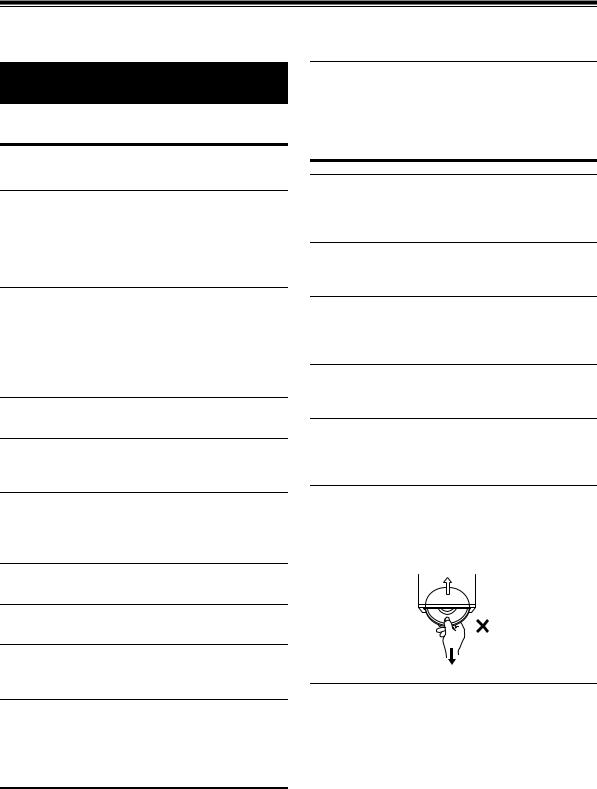
Operating Instructions
WARNING
WARNING
This symbol means important instructions. Failure to heed them can result in serious injury or death.
DO NOT OPERATE ANY FUNCTION THAT TAKES YOUR ATTENTION AWAY FROM SAFELY DRIVING YOUR VEHICLE.
Any function that requires your prolonged attention should only be performed after coming to a complete stop. Always stop the vehicle in a safe location before performing these functions. Failure to do so may result in an accident.
HALT USE IMMEDIATELY IF A PROBLEM APPEARS.
Failure to do so may cause personal injury or damage to the product. Return it to your authorized Alpine dealer or the nearest Alpine Service Centre for repairing.
PRECAUTIONS
Product Cleaning
Use a soft dry cloth for periodic cleaning of the product. For more severe stains, please dampen the cloth with water only. Anything else has the chance of dissolving the paint or damaging the plastic.
Temperature
Be sure the temperature inside the vehicle is between +60°C (+140°F) and −10°C (+14°F) before turning your unit on.
KEEP THE VOLUME AT A LEVEL WHERE YOU CAN STILL HEAR OUTSIDE NOISES WHILE DRIVING.
Excessive volume levels that obscure sounds such as emergency vehicle sirens or road warning signals (train crossings, etc.) can be dangerous and may result in an accident. LISTENING AT LOUD VOLUME LEVELS IN A CAR MAY ALSO CAUSE HEARING DAMAGE.
DO NOT DISASSEMBLE OR ALTER.
Doing so may result in an accident, fire or electric shock.
USE ONLY IN CARS WITH A 12 VOLT NEGATIVE GROUND.
(Check with your dealer if you are not sure.) Failure to do so may result in fire, etc.
Moisture Condensation
You may notice the CD playback sound wavering due to condensation. If this happens, remove the disc from the player and wait about an hour for the moisture to evaporate.
Damaged Disc
Do not attempt to play cracked, warped, or damaged discs. Playing a bad disc could severely damage the playback mechanism.
Maintenance
If you have problems, do not attempt to repair the unit yourself. Return it to your Alpine dealer or the nearest Alpine Service Station for servicing.
KEEP SMALL OBJECTS SUCH AS BATTERIES OUT OF THE REACH OF CHILDREN.
Swallowing them may result in serious injury. If swallowed, consult a physician immediately.
Never Attempt the Following
Do not grip or pull out the disc while it is being pulled back into the player by the automatic reloading mechanism.
Do not attempt to insert a disc into the unit when the unit power is off.
USE THE CORRECT AMPERE RATING WHEN REPLACING FUSES.
Failure to do so may result in fire or electric shock.
DO NOT BLOCK VENTS OR RADIATOR PANELS.
Doing so may cause heat to build up inside and may result in fire.
USE THIS PRODUCT FOR MOBILE 12V APPLICATIONS.
Use for other than its designed application may result in fire, electric shock or other injury.
DO NOT PLACE HANDS, FINGERS OR FOREIGN OBJECTS IN INSERTION SLOTS OR GAPS.
Doing so may result in personal injury or damage to the product.
CAUTION
This symbol means important instructions. Failure to heed them can result in injury or material property damage.
Inserting Discs
Your player accepts only one disc at a time for playback. Do not attempt to load more than one disc.
Make sure the label side is facing up when you insert the disc. “ERROR” will be displayed on your player if you insert a disc incorrectly. If “ERROR” continues to be displayed even though the disc has been inserted correctly, push the RESET button with a pointed object such as a ballpoint pen.
Playing a disc while driving on a very bumpy road may result in skips, but this will not scratch the disc or damage the player.
6-EN

New Discs
To prevent the CD from jamming, “ERROR” is displayed if discs with irregular surfaces are inserted or if discs are inserted incorrectly. When a new disc is ejected immediately after initial loading, use your finger to feel around the inside of the centre hole and outside edge of the disc. If you feel any small bumps or irregularities, this could inhibit proper loading of the disc. To remove the bumps, rub the inside edge of the hole and outside edge of the disc with a ballpoint pen or other such instrument, and then insert the disc again.
Centre Hole |
Centre Hole |
|
New Disc |
Bumps |
Outside |
|
(Bumps) |
If the surface is heavily soiled, dampen a clean, soft cloth in a solution of mild neutral detergent before cleaning the disc.
Disc Accessories
There are various accessories available on the market for protecting the disc surface and improving sound quality. However, most of them will influence the thickness and/or diameter of the disc. Using such accessories can cause the disc to be out of standard specifications and may create operational problems. We recommend not using these accessories on discs played in Alpine CD players.
Irregular Shaped Discs
Be sure to use round discs only for this unit and never use any |
|
|
special shaped discs. |
Transparent Sheet |
Disc Stabilizer |
Use of special shape discs may cause damage to the mechanism. |
Installation Location
Make sure this unit will not be installed in a location subjected to:
•Direct sun and heat
•High humidity and water
•Excessive dust
•Excessive vibrations
Correct Handling
Do not drop the disc while handling. Hold the disc so you will not leave fingerprints on the surface. Do not affix tape, paper, or gummed labels to the disc. Do not write on the disc.
CORRECT
INCORRECT |
CORRECT |
Disc Cleaning
Fingerprints, dust, or soil on the surface of the disc could cause the CD player to skip. For routine cleaning, wipe the playing surface with a clean, soft cloth from the centre of the disc to the outer edge.
On handling Compact Discs (CD/CD-R/CD-RW)
•Do not touch the surface.
•Do not expose the disc to direct sunlight.
•Do not affix stickers or labels.
•Clean the disc when it is dusty.
•Make sure that there are no bumps around the disc.
•Do not use commercially available disc accessories.
Do not leave the disc in the car or the unit for a long time. Never expose the disc to direct sunlight. Heat and humidity may damage the CD and you may not be able to play it again.
To customers using CD-R/CD-RW
•If a CD-R/CD-RW cannot be played back, make sure the last recording session was closed (finalised).
•Finalise the CD-R/CD-RW if necessary, and attempt playback again.
About media that can be played
Use only compact discs with the label side showing the CD logo marks below.
If you use unspecified compact discs, correct performance cannot be guaranteed.
You can play CD-Rs (CD-Recordables)/CD-RWs (CD-ReWritables) which have been recorded only on audio devices. You can also play CD-Rs/CD-RWs containing MP3/WMA/AAC formatted audio files.
•Some of the following CDs may not play on this unit: Flawed CDs, CDs with fingerprints, CDs exposed to extreme
temperatures or sunlight (e.g., left in the car or this unit), CDs recorded under unstable conditions, CDs on which a recording failed or a re-recording was attempted, copy-protected CDs which do not conform to the audio CD industry standard.
•Use discs with compressed audio files written in a format compatible with this unit. For details, refer to “About MP3/WMA/AAC” on page 14.
•ROM data other than audio files contained in a disc will not produce sound when played back.
7-EN

Protecting the USB Port
•Only USB Flash Memory devices can be connected to the USB port on this unit. Correct performance using other USB products cannot be guaranteed. A USB hub is not supported.
•Depending on the shape or size of a USB memory device, it may not be connected to the USB terminal of this unit-a USB extension (sold separately) is recommended for this connection.
Also, avoid connecting USB memory and Front Aux at the same time.
•If a USB device is inserted in the unit, it projects out and may be a danger while driving.
Use a commercially available USB extension cable, and connect it in a safe way.
•Depending on the connected USB Memory device, the unit may not function or some functions may not be performed.
•The audio file format that can be played back on the unit is MP3/ WMA/AAC.
•Artist/song name, etc., can be displayed, however some characters may not be correctly displayed.
On Handling USB Memory
CAUTION
Alpine accepts no responsibility for lost data, etc., even if data, etc., is lost while using this product.
•To prevent malfunction or damage, note the following points. Read the USB Memory Owner’s Manual thoroughly.
Do not touch the terminals by hand or metal. Do not subject USB Memory to excessive shock.
Do not bend, drop, disassemble, modify or soak in the water.
•Fix the USB Memory in a location where driver operation will not be hindered.
•USB Memory may not function correctly at high or low temperature.
•Use only certified USB Memory. Please pay attention that even certified USB Memory, may not function correctly depending on its type or state.
•USB Memory function is not guaranteed. Use USB Memory according to the terms of agreement.
•Depending on the settings of the USB Memory type, memory state or encoding software, the unit may not play back or display properly.
•A file that is copy-protected (copyright protection) cannot be played back.
•USB Memory may take time to start playback. If there is a particular file other than audio in the USB Memory, it may take considerable time before the file is played back or searched.
•The unit can play back “mp3”, “wma” or “m4a” file extensions.
•Do not add the above extensions to a file other than audio data. This non-audio data will not be recognised. The resulting playback may contain noise that can damage speakers and/or amplifiers.
•It is recommended to back up important data on a personal computer.
•Do not remove the USB device while playback is in progress. Change SOURCE to something other than USB, and then remove the USB device to prevent possible damage to its memory.
•iPhone, iPod, iPod classic, iPod nano, and iPod touch are trademarks of Apple Inc., registered in the U.S. and other countries.
•“Made for iPod,” and “Made for iPhone,” mean that an electronic accessory has been designed to connect specifically to iPod, or iPhone, respectively, and has been certified by the developer to meet Apple performance standards. Apple is not responsible for the operation of this device or its compliance with safety and regulatory standards. Please note that the use of this accessory with iPod, or iPhone may affect wireless performance.
•The BLUETOOTH® word mark and logos are registered trademarks owned by the Bluetooth SIG, Inc. and any use of such marks by Alpine Electronics, Inc. is under licence.
•Windows Media and the Windows logo are trademarks, or registered trademarks of Microsoft Corporation in the United States and/or other countries.
•MPEG Layer-3 audio coding technology licensed from Fraunhofer IIS and Thomson. Supply of this product only conveys a licence for private, non-commercial use and does not convey a licence nor imply any right to use this product in any commercial (i.e. revenue-generation) real time broadcasting (terrestrial, satellite, cable and/or any other media), broadcasting/streaming via internet, intranets and/or other networks or in other electronic content distribution systems, such as pay-audio or audio-on-demand applications. An independent licence for such use is required. For details, please visit http://www.mp3licensing.com
•© 2012 Nokia. All rights reserved. Nokia and Works with Nokia are trademarks or registered trademarks of Nokia Corporation.
8-EN
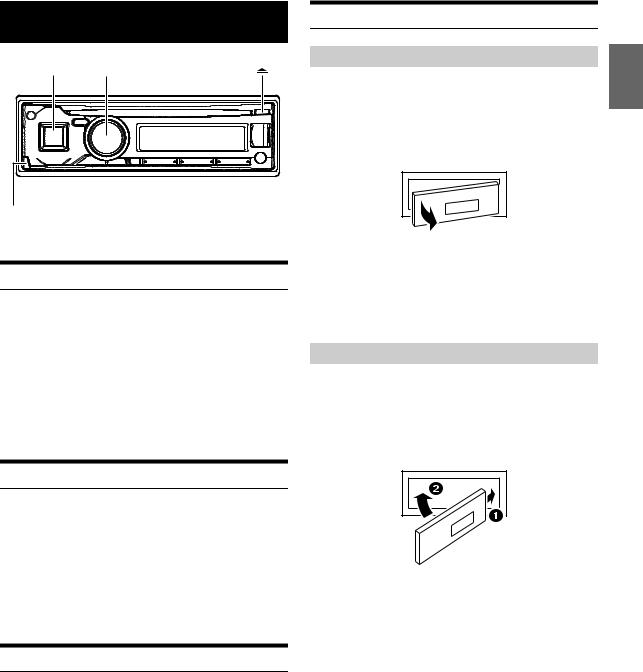
Getting Started
SOURCE/ Rotary encoder
|
e |
|
* The illustration is for CDE-173BT. |
|
|
Accessory List |
|
|
• |
Head Unit .................................................................................. |
1 |
• |
Power Cable .............................................................................. |
1 |
• |
Microphone .............................................................................. |
1 |
• USB extension cable (CDE-174BT only) .................................. |
1 |
|
• |
Mounting Sleeve ...................................................................... |
1 |
• |
Carrying Case............................................................................ |
1 |
• |
Bracket Key ............................................................................... |
2 |
• |
Rubber Cap ............................................................................... |
1 |
• |
Hex Bolt..................................................................................... |
1 |
• Screw (M5 × 8) .......................................................................... |
4 |
|
• |
Owner’s Manual.................................................................. |
1 set |
Detaching and Attaching the Front Panel
Detaching
1Turn off the unit power.
2Press e(Release) at the lower left side until the front panel pops out.
3Grasp the left side of the front panel and pull it out.
Notes
•The front panel may become hot in normal usage (especially the connector terminals on the back of the front panel). This is not a malfunction.
•To protect the front panel, place it in the supplied carrying case.
•When detaching the front panel, do not apply excessive force as it may result in malfunction.
Attaching
1Insert the right side of the front panel into the main unit. Align the groove on the front panel with the projections on the main unit.
2Push the left side of the front panel until it locks firmly into the main unit.
Turning Power On and Off
Press SOURCE to turn on the unit.
Note
•The unit can be turned on by pressing any other button except and e(Release).
Press and hold SOURCE for at least 2 seconds to turn off the unit.
Note
• The first time power is turned on, the volume will start from level 12.
Source Selection
Press SOURCE to change the source.
TUNER DISC*1 USB AUDIO/iPod*2 BT AUDIO*3 AUXILIARY*4 TUNER
*1 Only for CDE-174BT/CDE-173BT.
*2 Only when the iPod/iPhone is connected.
*3 Only when BT IN is set to ON. Refer to “Setting the BLUETOOTH Connection (BT IN)” on page 24.
*4 Only when AUX SETUP is set to ON. Refer to “Setting the AUX SETUP mode” on page 22.
Notes
•Before attaching the front panel, make sure that there is no dirt or dust on the connector terminals and no foreign object between the front panel and the main unit.
•Attach the front panel carefully, holding the sides of the front panel to avoid pushing buttons by mistake.
9-EN
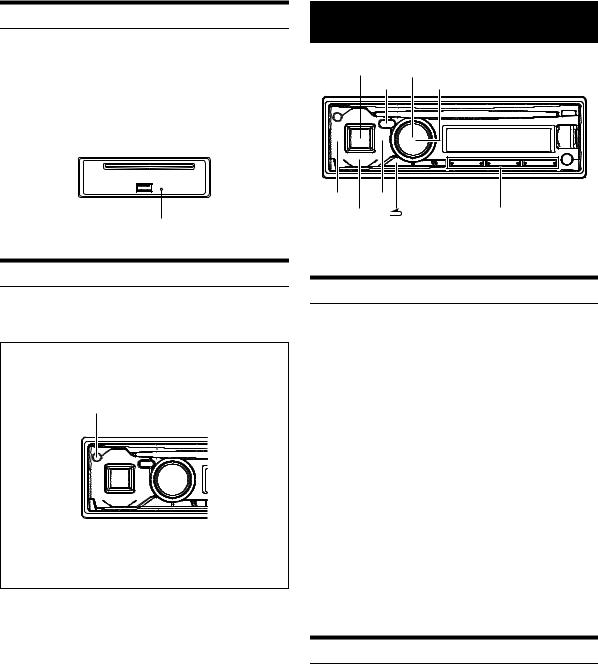
Initial System Start-Up
Be sure to press the RESET button when using the unit for the first time, after changing the car battery, etc.
1Turn off the unit power.
2Remove the detachable front panel.
3Press RESET with a ballpoint pen or similar pointed object.
RESET button
Adjusting Volume
Turn the Rotary encoder until the desired sound is obtained.
Controllable with Remote Control
This unit can be controlled with an optional Alpine remote control. For details, consult your Alpine dealer. Point the optional remote control transmitter at the remote-control sensor.
Remote control sensor
Connectable to Remote Control Interface Box
With an optional Alpine Steering Wheel Remote Control Interface Box (not included), this unit is controllable from the vehicles steering wheel controls. For details, contact your Alpine dealer.
Radio
SOURCE/ |
Rotary encoder |
|
|
TUNE/A.ME /ENTER |
|
|
|
|
BAND |
Preset buttons |
|
(1 through 6) |
* The illustration is for CDE-173BT.
Listening to Radio
1Press SOURCE to select TUNER mode.
2Press BAND repeatedly until the desired radio band is displayed.
F1 (FM1) F2 (FM2) F3 (FM3) MW LW F1 (FM1)
3Press TUNE A.ME to select the tuning mode.
r(Distance mode) t(Local mode) off (Manual mode) r
Note
• The initial mode is Distance mode.
Distance mode:
Both strong and weak stations will be automatically tuned in (Automatic Seek Tuning).
Local mode:
Only strong stations will be automatically tuned in (Automatic Seek Tuning).
Manual mode:
The frequency is manually tuned in steps (Manual tuning).
4Press or to tune in the desired station.
In Manual mode, holding down or will change the frequency continuously.
Presetting Stations Manually
1Select the radio band and tune in a desired radio station you wish to store in the preset memory.
2Press and hold, for at least 2 seconds, any one of the preset buttons (1 through 6) into which you wish to store the station.
The selected station is stored.
The display shows the band, preset number and station frequency memorized.
Notes
•A total of 30 stations can be stored in the preset memory (6 stations for each band; FM1, FM2, FM3, MW and LW).
10-EN
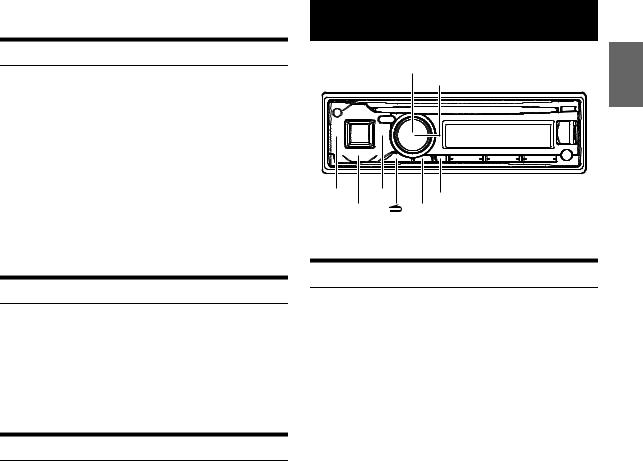
•If you store a station in a preset memory which already has a station, the current station will be cleared and replaced with the new station.
Presetting Stations Automatically
1Press BAND repeatedly until the desired radio band is displayed.
2Press and hold TUNE A.ME for at least 2 seconds.
The frequency on the display continues to change while the automatic memory is in progress. The tuner will automatically seek and store 6 strong stations in the selected band. They will be stored into preset buttons 1 to 6 in order of signal strength. When the automatic memory has been completed, the tuner goes to the station stored in preset location No.1.
Note
•If no stations are stored, the tuner will return to the original station you were listening to before the auto memory procedure began.
Tuning to Preset Stations
1Press BAND repeatedly until the desired band is displayed.
2Press any one of the station preset buttons (1 through 6) that has your desired radio station in memory.
The display shows the band, preset number and frequency of the station selected.
Frequency Search Function
You can search for a radio station by its frequency.
1Press ENTER in Radio mode to activate Frequency search mode.
The “ ” indicator lights up.
2Turn the Rotary encoder to select the desired frequency.
3Press ENTER to receive the selected frequency.
Note
•Press rin the search mode to cancel. Or, the search mode will be cancelled if no operation is performed for 60 seconds.
RDS
Rotary encoder
|
|
/ENTER |
|
|
VIEW |
|
|
|
BAND/TA |
AUDIO/SETUP |
|
* The illustration is for CDE-173BT.
Turning AF (Alternative Frequencies) ON/OFF
The RDS (Radio Data System) is a radio information system using the 57 kHz subcarrier of regular FM broadcast. The RDS allows you to receive a variety of information such as traffic information, station names, and to automatically re-tune to a stronger transmitter that is broadcasting the same programme.
1Press and hold AUDIO SETUP for at least 2 seconds to activate the SETUP selection mode.
2Turn the Rotary encoder to select the “TUNER” setup mode, and then press ENTER.
3Turn the Rotary encoder to select the “AF”, and then press
ENTER.
4Turn the Rotary encoder to select the AF (Alternative Frequency) ON or OFF mode.
5Press and hold AUDIO SETUP for at least 2 seconds to return to normal mode.
Notes
•When the AF ON mode is selected, the unit automatically tunes to a strong signal station in the AF list.
•Use the AF OFF mode when automatic re-tuning is not required.
•Press rto return to the previous mode.
•Pressing and holding rfor at least 2 seconds will return to normal mode.
•If no operation is performed for 60 seconds, the unit will return to normal mode automatically.
The RDS digital data includes the following:
PI |
Programme Identification |
|
|
PS |
Programme Service Name |
|
|
AF |
List of Alternative Frequencies |
|
|
TP |
Traffic Programme |
|
|
TA |
Traffic Announcement |
|
|
PTY |
Programme Type |
|
|
EON |
Enhanced Other Networks |
|
|
11-EN

Receiving RDS Regional (Local) Stations
1Press and hold AUDIO SETUP for at least 2 seconds to activate the SETUP selection mode.
2Turn the Rotary encoder to select the “TUNER” setup mode, and then press ENTER.
3Turn the Rotary encoder to select the “REGIONAL”, and then press ENTER.
4Turn the Rotary encoder to select “REG ON” or “REG OFF”.
In the OFF mode, the unit automatically keeps receiving the related local RDS station.
5Press and hold AUDIO SETUP for at least 2 seconds to return to normal mode.
Notes
•Press rto return to the previous mode.
•Pressing and holding rfor at least 2 seconds will return to normal mode.
•If no operation is performed for 60 seconds, the unit will return to normal mode automatically.
PI SEEK Setting
1Press and hold AUDIO SETUP for at least 2 seconds to activate the SETUP mode.
2Turn the Rotary encoder to select the “TUNER” setup mode, and then press ENTER.
3Turn the Rotary encoder to select “PI SEEK”, and then press ENTER.
4Turn the Rotary encoder to select “PISEEK ON” or “PISEEK OFF”.
5Press and hold AUDIO SETUP for at least 2 seconds to return to normal mode.
Notes
•Press rto return to the previous mode.
•Pressing and holding rfor at least 2 seconds will return to normal mode.
•If no operation is performed for 60 seconds, the unit will return to normal mode automatically.
Receiving Traffic Information
1Press and hold BAND TA for at least 2 seconds so that the
“G” indicator lights up.
2Press or to select your desired traffic information station.
When a traffic information station is tuned in, the “T” indicator lights up.
Traffic information is heard only when it is being broadcast. If traffic information is not being broadcast, the unit is set in the standby mode. When a traffic information broadcast begins, the unit automatically receives it and the display shows “TRF-INFO” for 2 seconds.
When the traffic information broadcast is over, the unit will automatically set in the standby mode.
Notes
•If you do not want to listen to the traffic information being received, lightly press BAND TA to skip that traffic information message. The TA mode will remain in the ON position to receive the next traffic information message.
•If the volume level is changed while receiving traffic information, the changed volume level will be memorized. When traffic information is received next time, the volume level will be automatically adjusted to the level memorized.
•In the TA mode, the SEEK tuning selects only the TP stations.
Receiving Traffic Information While Playing USB Audio or Radio
1Press and hold BAND TA for at least 2 seconds so that the
“G” indicator lights up.
2Press or to select a traffic information station if necessary.
When a traffic information broadcast starts, the unit automatically mutes the audio source (such as CD, regular FM broadcast, USB AUDIO, etc.).
When the traffic information broadcast finishes, the unit automatically returns to the original source play before the traffic information broadcast began.
When traffic information stations cannot be received:
In the tuner mode:
When the TP signal can no longer be received for over 1 minute, the “G” indicator blinks.
In other audio source mode:
When the TP signal can no longer be received, the traffic information station of another frequency will be selected automatically.
Note
•The receiver is equipped with the EON (Enhanced Other Networks) function in order to keep track of additional alternate frequencies to the AF list. If the station being received does not broadcast the traffic information, the receiver automatically tunes in the related station that broadcasts the traffic information when it occurs.
3Press and hold BAND TA for at least 2 seconds to deactivate the Traffic Information mode.
The “G” indicator goes out.
Displaying Radio Text
Text messages from a radio station can be displayed.
Press VIEW while receiving FM in the radio mode to select the Radio Text display.
The display will change every time the button is pressed. For details, refer to “Displaying the Text” on page 19.
12-EN
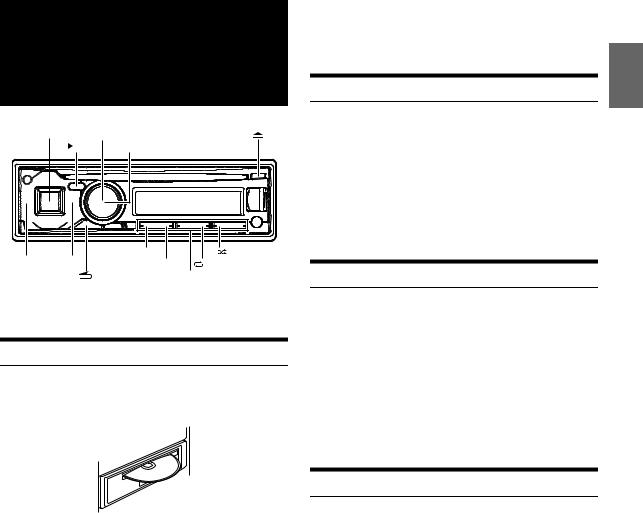
CD/MP3/WMA/AAC (CDE-174BT/CDE-173BT only)
SOURCE/ |
Rotary encoder |
|
|||
|
|
/ II |
/ENTER |
|
|
|
|
|
5 |
||
|
4 |
||||
|
|
|
|||
|
|
|
Preset buttons |
||
|
|
|
(1 through 6) |
||
* The illustration is for CDE-173BT.
Playback
1Insert a disc with the label side facing up.
The disc will be pulled into the unit automatically.
Note
•When a disc is already inserted, press SOURCE to switch to the DISC mode.
2While playing back MP3/WMA/AAC, press or to select the desired folder.
Pressing and holding or will change folders continuously.
3Press or to select the desired track (file).
Pressing and holding or will fast backward/fast forward track continuously.
4To pause playback, press .
Pressing again will resume playback.
5To eject the disc, press .
Notes
•Do not remove a CD during its eject cycle. Do not load more than one disc at a time. A malfunction may result from doing either.
•The “ ” indicator lights up when a disc is inserted.
•Three-inch (8 cm) CDs cannot be used.
•Any file protected by DRM (Digital Rights Management) copy protection, cannot be played back on this unit.
•The track display for MP3/WMA/AAC data playback is the file numbers recorded on the disc.
•The playback time may not be correctly displayed when a VBR (Variable Bit Rate) recorded file is played back.
•During CD/MP3/WMA/AAC playback, press r, and then you can quickly return to the hierarchy level selected last time in the search mode.
Repeat Play
1Press z4.
The song is played back repeatedly. a*1 a *2 (off) a
*1 Only a track/file is repeatedly played back.
*2 Only files in a folder are repeatedly played back. (MP3/WMA/ AAC mode only)
2To cancel repeat play, select (off) with the above procedure.
M.I.X. (Random Play)
1Press 5 x.
The songs are played back in random sequence.
s*1 g*2/*3 (off) s
*1 Only files in a folder are played back in random sequence.
(MP3/WMA/AAC mode)
*2 The tracks/files in the disc are played back in random sequence.
(CD or MP3/WMA/AAC mode)
*3 In the USB mode, all files stored in the USB Memory are played back in random sequence.
2To cancel M.I.X. play, select (off) with the above procedure.
Searching for CD Text
On discs utilizing CD Text, songs can be searched and played by using their recorded titles. For discs without CD Text, searches are made using the track numbers associated with each song.
1Press ENTER during play.
This will set the search mode, and the “ ” indicator lights up.
2Turn the Rotary encoder to select the desired track, and then press ENTER.
This will play the selected track.
Notes
•Press rin the search mode to cancel. Or, the search mode is cancelled if no operation is performed for 60 seconds.
•When CD Text Search is made during M.I.X. play, the M.I.X. play mode will be cancelled.
•If any one of the preset buttons (1 through 6) is pressed in the search mode, a search can be made quickly by skipping to the specified location. For details, refer to “Direct Search Function” on page 31.
13-EN

Folder/File Name Search
(concerning MP3/WMA/AAC)
Folder and file names may be searched and displayed during playback.
Folder Name Search mode
1During MP3/WMA/AAC playback, press ENTER to activate the search mode.
The “ ” indicator lights up.
2Turn the Rotary encoder to select Folder Name Search mode, and then press ENTER.
3Turn the Rotary encoder to select the desired folder.
4Press and hold ENTER for at least 2 seconds to play back the first file in the selected folder.
Notes
•If any one of the preset buttons (1 through 6) is pressed in the Folder Name search mode, a search can be made quickly by skipping to the specified location. For details, refer to “Direct Search Function” on page 31.
•Press and hold rfor at least 2 seconds in the search mode to cancel. Or, the search mode is cancelled if no operation is performed for 60 seconds.
•To search for files in the Folder Name Search mode, press ENTER. Files in the folder may be searched.
•Press rto exit Folder Name Search mode in step 3 in order to select File Name Search mode.
•The root folder is displayed as “\ROOT”.
•When Folder Name Search is made during M.I.X. play, the M.I.X. play mode will be cancelled.
File Name Search mode
1During MP3/WMA/AAC playback, press ENTER to activate the search mode.
The “ ” indicator lights up.
2Turn the Rotary encoder to select File Name Search mode, and then press ENTER.
3Select the desired file by turning the Rotary encoder.
4Press ENTER to play back the selected file.
Notes
•If any one of the preset buttons (1 through 6) is pressed in the File Name search mode, a search can be made quickly by skipping to the specified location. For details, refer to “Direct Search Function” on page 31.
•Press and hold rfor at least 2 seconds in the search mode to cancel. Or, the search mode is cancelled if no operation is performed for 60 seconds.
•Press rin the search mode to return to the previous mode.
•When File Name Search is made during M.I.X. play, the M.I.X. play mode will be cancelled.
Search Position Memory
During playback, you can quickly return to the last-selected hierarchy level in the search mode.
Press r.
The hierarchy you selected last in the search mode is displayed.
About MP3/WMA/AAC
CAUTION
Except for private use, duplicating audio data (including MP3/ WMA/AAC data) or distributing, transferring, or copying it, whether for free or for a fee, without permission of the copyright holder is strictly prohibited by the Copyright Act and by international treaty.
What is MP3?
MP3, whose official name is “MPEG Audio Layer 3,” is a compression standard prescribed by the ISO, the International Standardization Organization and MPEG which is a joint activity institution of the IEC. MP3 files contain compressed audio data. MP3 encoding is capable of compressing audio data at extremely high ratios, reducing the size of music files to as much as one-tenth their original size. This is achieved while still maintaining near CD quality. The MP3 format realises such high compression ratios by eliminating the sounds that are either inaudible to the human ear or masked by other sounds.
What is WMA?
WMA, or “Windows Media™ Audio,” is compressed audio data. WMA is similar to MP3 audio data.
What is AAC?
AAC is the abbreviation for “Advanced Audio Coding,” and is a basic format of audio compression used by MPEG2 or MPEG4.
Method for creating MP3/WMA/AAC files
Audio data is compressed using software with MP3/WMA/AAC codecs. For details on creating MP3/WMA/AAC files, refer to the user’s manual for that software.
MP3/WMA/AAC files that are playable on this device have the file extensions “mp3” / “wma” / “m4a”. Files with no extension cannot be played back (WMA ver. 7.1, 8 and 9 are supported). Protected files are not supported, neither are raw AAC files (using the “.aac” extension). There are many different versions of the AAC format. Confirm that the software being used conforms to the acceptable formats listed above. It’s possible that the format may be unplayable even though the extension is valid.
Playback of AAC files encoded by iTunes is supported.
Supported playback sampling rates and bit rates
MP3 |
|
Sampling rates: |
48 kHz, 44.1 kHz, 32 kHz, 24 kHz, 22.05 kHz, 16 kHz, |
|
12 kHz, 11.025 kHz, 8 kHz |
Bit rates: |
8 - 320 kbps |
WMA |
|
Sampling rates: |
48 kHz, 44.1 kHz, 32 kHz |
Bit rates: |
32 - 192 kbps |
AAC |
|
Sampling rates: |
48 kHz, 44.1 kHz, 32 kHz, 24 kHz, 22.05 kHz, 16 kHz, |
|
12 kHz, 11.025 kHz, 8 kHz |
Bit rates: |
16 - 320 kbps |
This device may not play back correctly depending on sampling rates.
14-EN
